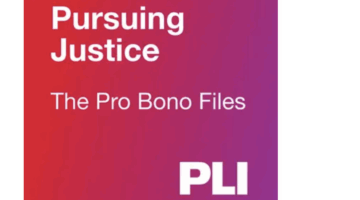I’m back in New York City — a place that has infinitely more Puerto Rican culture than a Hilton in Puerto Rico. But I still have a few more write-ups from the 2010 NALP Annual Education Conference. I’d be remiss if I didn’t bring back a little information for the hordes of lawyers laid off or shut out of Biglaw during the recession. Rest assured, you are not alone.
On Friday afternoon, I attended a panel called “The State of the Legal Economy and the Legal Employment Market.” This should have been the highlight event for the conference. The only panelist was James Leipold, Executive Director of NALP, and he was slated to talk about the hard numbers NALP has put together describing the recession. The panel was booked for the largest conference room in the hotel — the room easily sat 250 people.
Total attendance = 12 people (I counted). The lesson: do not hold your executive summary panel at 3:30 on Friday in Puerto Rico.

Pursuing The Pro Bono Story: A Conversation With Alicia Aiken
This Pro Bono Week, get inspired to give back with PLI’s Pursuing Justice: The Pro Bono Files, a one-of-a-kind podcast hosted by Alicia Aiken.
Why was I there? That’s not a rhetorical question. I’m actually confused as to how I ended up covering a panel with 11 other attendees. The room was so cold (air conditioning for 250) that I’m convinced that when conference room air met the Puerto Rican humidity, it caused the tropical depression that hammered the Gulf Coast over the weekend.
In any event, I received some hard numbers for my trouble. And I got to hear Leipold’s thoughts on just how screwed the “Lost Generation” of would-be Biglaw associates are. Not good times, my friends. Try not to finish your cup of hemlock before you hear the numbers…
The NALP numbers were almost uniformly depressing. One slide I found particularly apocalyptic was the “Outcomes of Summer Programs.” If you look at summer offer rates, it’s been consistently around 90% or above for years now. Even in the dark days post-9/11, the offer rates only fell to 81%. But check out the numbers for 2009:

3 Ways Lawyers Are Finding New Efficiencies With AI
Those who’ve adopted legal-specific systems are seeing big benefits.
Outcomes of Summer Programs: Entry Level Offer Rate
2009 – 69%
2008 – 90%
2007 – 93%
2006 – 93%
2005 – 91%
2004 – 91%
2003 – 87%
2002 – 81%
Last year, 2009, was an historic low.
And for 3Ls who return to campus without an offer? Well, you’d need to make up an entirely new curse word to describe how utterly screwed they are. I’d call them “mofongoed” (after a mushy Puerto Rican staple I did not enjoy). Check out these percentages of on-campus recruiters that are even looking for 3Ls:
Fall Recruiting Outcomes for the Class of 2010 (Current 3Ls): Number of Employers Recruiting 3Ls
2009 – 3%
2008 – 25%
2007 – 42%
2006 – 53%
2005 – 42%
2004 – 31%
2003 – 34%
2002 – 25%
And it’s not likely to get better for the class of 2011. Leipold said that they are already know that 17% of firms that had summer programs in 2009 have already canceled summer programs for 2010. Leipold told the crowd (crowd = me) that 55% of law schools have reported a decrease of 30% or more in the number of firms coming to campus. That’s the biggest drop NALP has ever recorded, and it all happened in a single year.
These are epically bad numbers. But don’t expect the carnage to show up in NALP’s employment numbers (due out sometime in the next couple of weeks). Despite all this bad news, Leipold expects the NALP statistics on graduates employed nine months after graduation to not fall below 80%. Why? Leipold talked about how law schools have responded to the recession by instituting a “jobs relief” package. Regular Above the Law readers know exactly what kind of low paying “jobs” Leipold is talking about, but here’s the slide:
Law School Responses to Recession: What programs did law schools implement as a result of the economic downturn?
1. Created or provided on-campus or post-graduate jobs: 42%
2. Increased the number of public interest fellowships: 31%
3. Provided financial assistance for bar exam related expenses: 12%
4. Extended access to student health benefits for recent grads: 12%
5. Expanded LRAP (loan repayment assistance) eligibility/increased LRAP benefits: 9%
6. Provided emergency loans otherwise not available: 5%
I love how only 9% of law schools actually helped students pay off their loans, but 42% provided some BS “job” that doesn’t even begin to support the high cost of legal education.
Of course, NALP counts the on-campus or post-graduate jobs as “employed.” And it counts people on public interest fellowships as employed. According to Leipold, these law school programs were:
“Not cynical, U.S. News gamesmanship by the deans. [These were] a job relief program.”
Whatever: 9% of law schools actually helped their students with their student debt obligations, 42% provided a job that will show up on U.S. News rankings. I think we know the true intentions of law school deans.
But Leipold told us that NALP is also counting deferred students as employed — even though NALP knows that some deferrals will never result in actual employment.
Since it was me, Leipold, and 11 other people who didn’t want to look tanned when they got back to work on Monday, I decided it was appropriate to question Leipold about this. Why was NALP providing “cover” for law schools when we all know that prospective law students will believe these inflated numbers? Doesn’t this make NALP complicit in this law school scam? To Leipold’s credit, he answered truthfully:
“If we said to law schools you have to report a significant percentage of your graduates as ‘unemployed,’ they wouldn’t do it.”
That’s right, Above the Law readers; never forget that law schools have no interest in accurately representing how detached the education they provide has become from getting a real job. At this panel and in many other sessions, NALP panelists emphasized the bi-modal salary distribution curve (popularized by IU Law Professor William Henderson of the Empirical Legal Studies blog):
The recession is simply going to push even more associates out to the left-hand, low-salary hump of the graph. Law schools don’t want you to know that — how can they sell legal education when it is so clearly not worth the sticker price? All NALP can really do is publicize the bi-modal distribution and hope that prospective law students aren’t too dumb to understand quantitative reasoning.
The employed-nine-months-after-graduation fiasco led Leipold into a larger discussion about the “lost generation”: students in the class of 2009, 2010, 2011, and maybe even 2012 that have been shut out of or laid off from Biglaw. Leipold didn’t have a lot of hopeful things to say to these people:
I don’t think Biglaw will ever reabsorb that group of people. Maybe a few individuals, but not statistically… For a large group of people that came of in age in this time … their career paths will look very different [than people who graduated during past boom times]…
It’s just their bad luck.
The truth might hurt, but it’s hard to deny what Leipold is saying from a statistical standpoint. There are more people signing up for law school than ever before. Talent keeps flowing into the system. At some point, soon perhaps, it will make more sense for Biglaw to hire fresh talent, talent that hasn’t been scarred by this recession, instead of going back and picking up people who got thrown off the bandwagon during the recession.
Essentially, people in the Lost Generation are looking for a spiritual adviser like John Locke, and are getting nothing but a can full of smoke monster. Much like Richard Alpert, I no longer have any answers, just a series of bad choices.
Earlier: NALP 2010: Résumé Advice = Mind the Gaps
NALP 2010: New Litigators be Warned